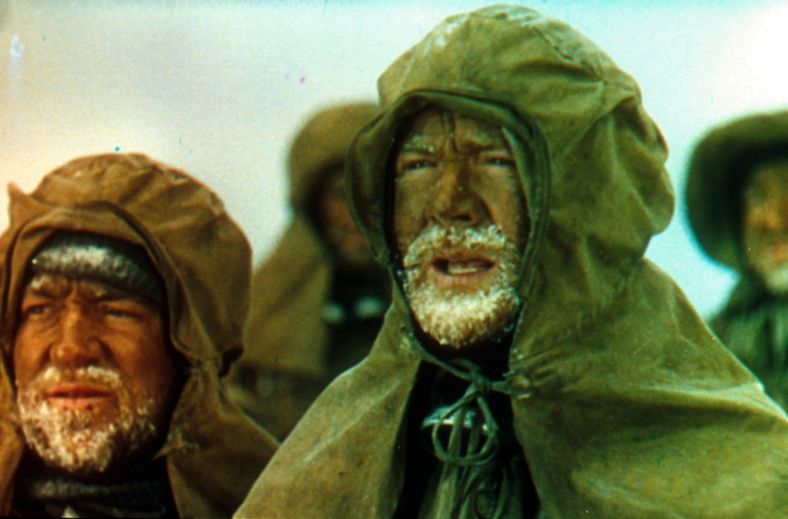SCOTT OF THE ANTARCTIC
(director: Charles Frend; screenwriters: Walter Meade/Ivor Montagu/Mary Hayley Bell; cinematographers: Osmond Borradaile/Jack Cardiff/Geoffrey Unsworth; editor: Peter Tanner; music: Vaughan Williams; cast: John Mills (Captain Scott), Diana Churchill (Kathleen Scott), Harold Warrender (Dr. Wilson), Anne Firth (Oriana Wilson), Derek Bond (Captain Oates), Reginald Beckwith (Lt. Bowers), James Robertson Justice (P.O. Taff Evans), Kenneth More (Lt. Teddy Evans), Christopher Lee (Bernard Day); Runtime: 110; MPAA Rating: NR; producer: Michael Balcon; Eagle-Lion Classics; 1948-UK)
“When all is said and done, this is an honest account of British Captain Scott’s doomed second expedition to the inhospitable South Pole.”
Reviewed by Dennis Schwartz
Historical film, in lush TechniColor, crisply directed by Charles Frend (“The Big Blockade”/”Johnny Frenchman”/ “The Cruel Sea”) as if a docudrama, that is done so low-key and so British that it was perhaps robbed of its inherent drama of the determined efforts of the brave explorers that ended in tragic failure and stunned England. The film was based on Captain Robert Falcon Scott’s log, that stated: “Had we lived I should have had a tale to tell of the hardihood, endurance and courage of my companions, which would have stirred the heart of every Englishman. It seems a pity, but I don’t think I can write more. These rough notes and our bodies must tell the tale…. For God’s sake, look after our people”).
It’s accurately written (more or less) by Walter Meade, Ivor Montagu and Mary Hayley Bell, who do a fine job capturing the feel of the Edwardian period and the downbeat part of the saga. The stiff-upper-lip ill-fated 1912 adventure story should have been more stirring considering its daredevil nature, but the understated performances were sincere, the snowscapes (shot in Ealing Studio, Norway, the Swiss Alps and South Pole) were visually appealing (even the fake snowscapes) and Vaughan Williams’ rousing score gave the film the excitement the story at times couldn’t give it. When all is said and done, this is an honest account of British Captain Scott’s doomed second expedition to the inhospitable South Pole, an unexplored continent that Scott hoped he would be the first to explore for country, fame and science. Scott’s previous expedition to the South Pole was in 1904, where he came within 90 miles of it.
The film opensshowing Scott (John Mills) desperately roaming around Edwardian England for private and government financing for his arctic expedition and also recruiting a crew. The exploration began in 1910 and took two years to reach the South Pole. Upon reaching it in 1912, Scott was dismayed to find the Norwegian flag planted there by explorer Roald Amundsen. Returning to England, Scott’s party of five men all perished in the snow.
A search party several months later would find the Scott diaries and pieced together the story that Edwardian England found stirring as an example of gallantry and courage by a small band of dedicated heroic men fighting impossible odds. The film tried to capture the highlights of this story, which it did except for the part of making it exciting. Too many of the characters could not be fleshed out for dramatic purposes, but the film comes through with a very touching finale.
The last shot is where the diary was found and on a cross that marked that place in the frozen wilderness were the words: “To strive, to seek, to find, and not to yield.”

REVIEWED ON 12/6/2009 GRADE: B